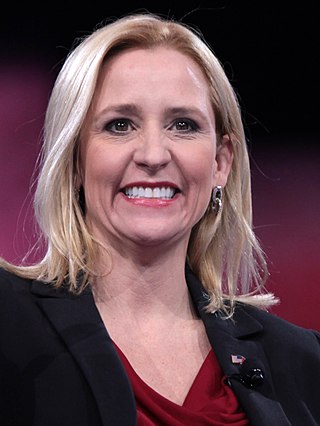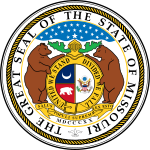The government of the U.S. state of Missouri is organized into the state government and local government, including county government, and city and municipal government.

The lieutenant governor and speaker of the Senate of Tennessee is the presiding officer of the Tennessee Senate and first in line in the succession to the office of governor of Tennessee in the event of the death, resignation, or removal from office through impeachment and conviction of the governor of Tennessee.
New York is a Democratic stronghold and is considered one of the "Big Three" Democratic strongholds alongside California and Illinois. The following table indicates the party of elected officials in the U.S. state of New York:

The lieutenant governor of New York is a constitutional office in the executive branch of the Government of the State of New York. It is the second highest-ranking official in state government. The lieutenant governor is elected on a ticket with the governor for a four-year term. Official duties dictated to the lieutenant governor under the present New York Constitution are to serve as president of the state senate, serve as acting governor in the absence of the governor from the state or the disability of the governor, or to become governor in the event of the governor's death, resignation or removal from office via impeachment. Additional statutory duties of the lieutenant governor are to serve on the New York Court for the Trial of Impeachments, the State Defense Council, and on the board of trustees of the College of Environmental Science and Forestry. The lieutenant governor of New York is the highest-paid lieutenant governor in the country.

The lieutenant governor of Nebraska is the highest-ranking executive official in the State of Nebraska after the governor. According to the Nebraska State Constitution, in the event a governor dies, becomes permanently incapacitated, resigns, or is removed from office, the lieutenant governor will become governor.

The lieutenant governor of Oklahoma is the second-highest executive official of the state government of Oklahoma. As first in the gubernatorial line of succession, the lieutenant governor becomes the new governor of Oklahoma upon the death, resignation, or removal of the governor. The lieutenant governor also serves as the president of the Oklahoma Senate, and may cast a vote to break ties in that chamber.

The lieutenant governor of Wisconsin is the first person in the line of succession of Wisconsin's executive branch, thus serving as governor in the event of the death, resignation, removal, impeachment, absence from the state, or incapacity due to illness of the governor of Wisconsin. Forty-one individuals have held the office of lieutenant governor since Wisconsin's admission to the Union in 1848, two of whom—Warren Knowles and Jack Olson—have served for non-consecutive terms. The first lieutenant governor was John Holmes, who took office on June 7, 1848. The current lieutenant governor is Sara Rodriguez, who took office on January 3, 2023.

The lieutenant governor of Arkansas presides over the Senate of the U.S. state of Arkansas with a tie-breaking vote, serves as acting governor of Arkansas when the governor is out of state and assumes the governorship in cases of impeachment, removal from office, death or inability to discharge the office's duties. The position is elected separately from the Arkansas Governor.

The Louisiana State Senate is the upper house of Louisiana’s legislature. Senators serve four-year terms and participate in various committees.

The lieutenant governor of Louisiana is the second highest state office in Louisiana. The current lieutenant governor is Billy Nungesser, a Republican. The lieutenant governor is also the commissioner of the Louisiana Department of Culture, Recreation & Tourism.
The lieutenant governor of Indiana is a constitutional office in the US state of Indiana. Republican Micah Beckwith, who assumed office January 13, 2025, is the incumbent. The office holder's constitutional roles are to serve as the president of the Indiana Senate, become acting governor during the incapacity of the governor, and become governor should the incumbent governor resign, die in office, or be impeached and removed from office. Lieutenant governors have succeeded ten governors following their deaths or resignations. The lieutenant governor holds statutory positions, serving as the head of the state agricultural and rural affairs bureaus, and as the chairman of several state committees.
The following table indicates the party of elected officials in the U.S. state of Georgia:
The following table indicates the party of elected officials in the U.S. state of Arkansas:
The following table indicates the party of elected officials in the U.S. state of Connecticut:
The following tables indicate party affiliation in the U.S. state of Florida for the individual elected offices of:
The following table indicates the party of elected officials in the U.S. state of Louisiana:
The following table indicates the party of elected officials in the U.S. state of Minnesota:
The following table indicates the party of elected officials in the U.S. state of Mississippi:
The following tables indicate the historic party affiliation of elected officials in the U.S. state of Wisconsin, including: Governor, Lieutenant Governor, Secretary of State, Attorney General, State Treasurer, Superintendent of Public Instruction. The tables also indicate the historical party composition in the State Senate, State Assembly, the State delegation to the United States Senate, and the State delegation to the United States House of Representatives. For years in which a United States presidential election was held, the tables indicate which party's nominees received the state's electoral votes.
















































